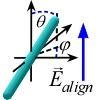Citation:

Abstract:
The expected permittivity and third-order nonlinear susceptibility of a composite consisting of semiconductor nanorods (NRs) dispersed in a polymer host are derived using a generalized Maxwell Garnett model under various NR axis orientation statistics, achieved by an aligning electric field. The semiconductor NRs are analyzed as prolate spheroids and modeled as more realistic capsule shapes. From the angular distribution function of the NRs, the composite macroscopic characteristics are found for low filling fractions. As the alignment field strength increases, the composite optical properties asymptotically converge toward the nematic case. Aligning fields of order 107 V∕m are required for the optical properties to increase to half the value between random orientation and nematic array composites. © 2013 Optical Society of America

